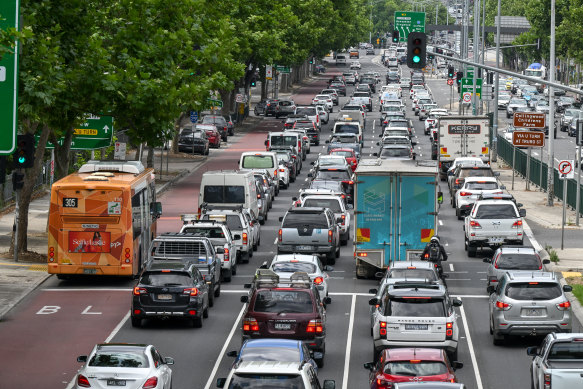State pockets $1.7b from TAC amid road safety crisis
The state government has pocketed $1.73 billion from the Transport Accident Commission over the past six years, bolstering its own coffers with more cash than the state-owned insurer spent on road safety upgrades.
And the cash-strapped Allan government intends to funnel another $2.4 billion from the state-owned insurance scheme over the next four years, budget papers show.

The Victorian Road Safety Strategy aims to halve deaths and serious injuries between 2021 and 2030.Credit: Eddie Jim
The state opposition says the TAC is being starved of funds urgently needed for safety programs to tackle rising road fatalities to stop the bleeding in the budget.
Victoria suffered its deadliest year on its roads in 15 years in 2023, with 295 people killed. As of midnight Thursday, 247 people have been killed so far in 2024 – the third-highest for this point of the year since 2009.
The TAC’s annual report, released on October 31, confirmed that it made a $1.08 billion dividend payment to the state government in the 2023-24 financial year, at the request of Treasurer Tim Pallas.
The treasurer has the right to demand a dividend or “capital repayment” from the insurer, after consultation with the organisation and TAC Minister Danny Pearson.
The TAC has paid $1.73 billion to the state Labor government since 2019, including capital repayments of $255 million in that year and $400 million in 2022.
That’s more than the $905 million the insurer has contributed to road safety infrastructure upgrades over the same period, and the $561 million it spent on marketing campaigns and research.
Motorists fund the TAC through a levy on their annual vehicle registration – which for a car is between $446 and $573, depending on where the driver lives. It also earns money from investments in shares and other assets.
The TAC reported $2.2 billion in insurance fee revenue and $1.7 billion from investments in FY2024, while it paid out $1.81 billion in benefits to 44,989 people injured in transport accidents.
Opposition road safety spokesperson Danny O’Brien accused the government of raiding the TAC to prop up other parts of the budget.
He said it had “clearly come at the expense of road safety improvements” such as roadside barriers and tactile line marking.
O’Brien pointed out that the state government’s Road Safety Fund – which receives the TAC’s road upgrade contributions – had been revised down from an expected $148 million to $59.8 million in FY2024.
“These are important programs that have been dumped at a time when the road toll has been rising for the past two years,” he said.
“The fact the Road Safety Fund has been gutted is further evidence that money from the TAC is just not flowing to projects and programs that will save lives and prevent injuries on our roads.”
A spokesperson for the Allan government said it had assessed the TAC’s capacity to make dividend payments after budgeting for its road safety initiatives.
“The TAC’s road safety budget is not impacted by payments to government. TAC increased its investment in road safety programs in 2023-24,” they said.
The TAC’s contribution to road funding projects has averaged $146 million annually over the past decade, but has been lower than average in the past two years at $55 million in FY2024 and $42 million in FY2023.
The insurer reported a $1.04 billion profit last year, off the back of strong investment returns and lower claims.
Its insurance funding ratio – a measure of its financial health – fell from 160 per cent to 151 per cent, which is still above its target range of 100 to 145 per cent. The fall was “primarily” due to the government dividend, the annual report said.
State budget papers forecast in May that the government will take another $300 million dividend from the TAC this financial year, $600 million next year and $1.5 billion in 2028.
Rob Morgan, an experienced Victorian road safety engineer and consultant, said more funding was needed to improve dangerous roads if the state wanted to prevent fatal crashes and serious injuries.
“Everybody’s paying their TAC fee on their registration and that’s supposed to be for road safety,” Morgan said.
“Every dollar that’s taken as a dividend is a dollar that cannot be spent on road safety.”
In addition to the decade-high fatalities, 1269 people suffered serious injuries in transport crashes in 2023, according to the TAC.
The Victorian Road Safety Strategy – developed by the state government, Victoria Police and TAC – aims to halve deaths and serious injuries between 2021 and 2030.
Pallas is also pulling cash from other state authorities and corporations to help pay down the state’s pandemic-era debt pile. The Age revealed last week that public water companies paid more than $651 million in dividends, capital repatriation payments and COVID or efficiency payments in FY2024.
A quarterly financial report tabled by Pallas on Friday showed Victoria’s net debt had grown by $7.4 billion to hit $140.7 billion at the end of September, as state finances are strained by growing interest payments, healthcare costs, and public sector wages.
Victoria’s net debt is expected to peak at $187.8 billion by the middle of 2028, which is equivalent to around one-quarter of the state economy.
Start the day with a summary of the day’s most important and interesting stories, analysis and insights. Sign up for our Morning Edition newsletter.